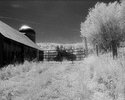I'd had problems with a couple of Foma RC prints (there was a url link here which no longer exists) when framed, and Sistan was recommended as a good preventative measure. So I bought a bottle, made up a batch and processed basically my whole back-archives of B&W RC prints, including from other paper vendors.
Well, that was a Really Stupid thing to do, because it has destroyed over half of my prints with serious bleaching in disgusting dribbly patterns that formed over about 8 weeks in dark storage. I'm talking about the loss of hundreds of dollars of paper and hundreds of hours of darkroom work here - prints that were in perfect condition are now good only for the bin - and I am extremely angry about it. I'll post some scans tomorrow, but believe me, the damage varies from "a spot" to "catastrophic"; it seems to be increasing and I suspect that I am going to lose all of my RC B&W prints. About 6 years worth!
Consider yourself warned in the most dire fashion possible.






